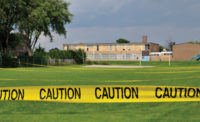Safe learning environments
Crime & violence aren’t the only concerns

School safety is on our minds due to recent tragedies, but it’s always been important to create and maintain safe learning environments.
Students, teachers and administrators all play an important role in promoting a solid vision of safe schools. Schools now provide additional training to develop, solidify and measure student supports already in place. The increase in crime and violence rates not only affect elementary and high school levels but also postsecondary education. According to the National Center for Education Statistics, “In 2012, there were 29,500 criminal incidents against persons and property on campus at public and private two- and four-year postsecondary institutions, reported to police and security agencies.”
Other issues
There are other equally important aspects of school safety. Additional concerns include laboratory safety and trade or technical class. Of course staff safety is paramount when addressing slips and trips, falls, ergonomics, and other issues faced on a daily basis.
Students often take part in learning principles of chemistry and chemical engineering and participate
in laboratory research at academic institution, but aren’t taught the safety skills that can avoid accidents and life-threatening incidents. Inadequate laboratory safety training and lack of commitment to safe laboratory practices will undoubtedly lead to compromised situations.
The disparity between the safety standards in learning institutions and professional safety standards for chemical engineering gives new hires a great disadvantage. According to the Council for Chemical Research, “A UCLA researcher lost their life due to burns sustained while working in the chemical lab. The root causes of this incident were a lack of training, poor personal protective equipment (PPE), no safe operating procedure and a lack of oversight.
“At Texas Tech University, an explosion in a chemical laboratory caused injuries to two students who were not following proper safety procedures in PPE and due to lack of oversight.”
The increase in these incidents has made schools focus more on creating programs for academic laboratory safety. The aim is to increase safety awareness, identify best safety practices applicable to the academic environment and develop tools to improve and sustain a culture of safety.
Funding problems
Many school districts have concentrated on active shooter and bully issues, and they also emphasis the other facets of safety. Some districts, especially smaller ones, face a dilemma: their EMR is so high that insurance companies are reluctant to insure them, or the rates are so high as to be unaffordable.
School districts lament they do not have funds to hire safety professionals. Perhaps the question is: “How much money could a quality safety professional save? Enough to easily pay the salary?”
The educators need educated. There is a glaring need for increased safety at all levels of education and we should help them determine the level of safety needed, the cost, and predicted savings.
Schools are like any other industry. Safety must be an integral part of their daily activities.
Sources:
Council for Chemical Research. Safety in Academic Laboratories. safety.dow.com
National Center for Education Statistics . Indicators of School Crime and Safety 2014. http://nces.ed.gov/programs/crimeindicators/crimeindicators2014/ind_22.asp
Looking for a reprint of this article?
From high-res PDFs to custom plaques, order your copy today!





